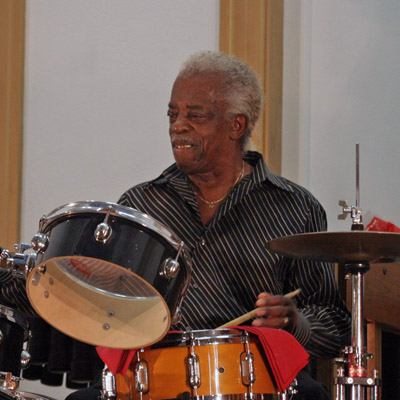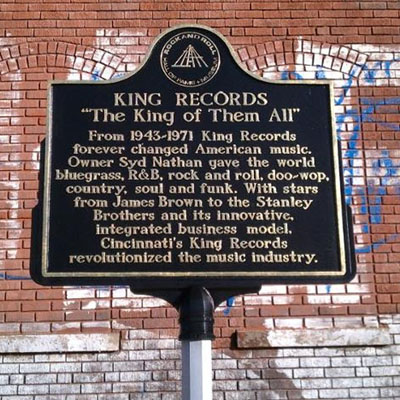Saving King Records
I can’t think of a more relevant day to be thinking about a Cincinnati landmark and treasure where some of the greatest music originated, and where civil rights and inclusion was modeled at its best. I hate to admit, when I was first hired to work on the Hidden Treasures CD many years back, I was unfamiliar with King Records. I quickly came to learn, under the helm of founder Syd Nathan, King was the first record label to consciously mix black and white music. For the first time in music’s history, a recording company had the foresight to embrace inclusion, to unite talent diverse not only by race, but also by ethnicity and religion; to blend country with R&B, big beat with six-string twang. Inclusion, King Records proved, breeds success. It stimulates creative thought and new approaches to problem solving…it created King’s blueprint – the blueprint of rock ‘n roll. Eight King Records artists have been inducted into the Rock and Roll Hall of Fame and more than 450 King tracks have been counted among Billboard’s Top 10 hits.
Today, that landmark is in real jeopardy of being demolished by its owner; however, because the site was declared a historic landmark in 2015, he needs permission from City Council. Mayor John Cranley wrote a beautifully detailed letter to City Council introducing a resolution allowing Cincinnati to acquire it.
In that letter, Mayor Cranley shared comments from Terry Stewart, president of the Roll and Roll Hall of Fame. Among them… “It bears repeating and underscoring… there’s not a more important piece of real estate in musical history than the building over there on Brewster. If you folks don’t remember and preserve it, shame on you. Remember it! It so important to American culture, world culture… what happened in that building.”
Also in his letter, Mayor Cranley wrote: “Since having the honor of serving as a Councilman, and especially since having the honor to become Mayor, I have been thrilled to see the increased excitement and community efforts around restoring the King Records legacy. The Cincinnati Public Library has led on amazing educational programming and events.  Cincinnati State Technical and Community College has been teaching King Records history in partnership with the Rock Hall. Artworks put up a James Brown mural. The Cincinnati Playhouse, Cincinnati Symphony and Cincinnati Pops have all put on King Records productions. We have finally seen books published on King Records like the ones by Jon Hartley Fox, Randy McNutt, and more. We even made the Sunday edition of The New York Times for placing a historic landmark plaque with the Rock and Roll Hall of Fame in front of the building we are looking to save today.”
Cincinnati State Technical and Community College has been teaching King Records history in partnership with the Rock Hall. Artworks put up a James Brown mural. The Cincinnati Playhouse, Cincinnati Symphony and Cincinnati Pops have all put on King Records productions. We have finally seen books published on King Records like the ones by Jon Hartley Fox, Randy McNutt, and more. We even made the Sunday edition of The New York Times for placing a historic landmark plaque with the Rock and Roll Hall of Fame in front of the building we are looking to save today.”
This is especially significant to me as I got to know, appreciate and admire through Hidden Treasures, the treasure of King Record’s legacy. One piece of that legacy is my very dear friends, Philip Paul, who was a studio drummer for King from 1952 to 1965 and who was part of several hundred recordings and hits…including the original version of ‘The Twist’ recorded by Hank Ballard and The Midnighters. I will never tire of his stories and am so happy to see him, as well as other King artists, being recognized.
A rally to save the King Records building will be held Tuesday, January 17th at 1pm at City Hall. If you can be there, you can be an important voice. You can also email CityCouncil@Cincinnati.oh.gov.
Mayor Cranley’s letter to Cincinnati City Council Members
Dear Colleagues –
I write today to update you on my efforts to save the former King Records Studio site from demolition and ask that you too join in this cause. I will also refer three ordinances to Budget and Finance committee introduced by Council members Simpson and Young to honor legendary musicians Otis Williams, Philip Paul and Bootsy Collins by renaming various streets in the Evanston neighborhood.
In 2015, together we recognized and honored the unparalleled achievements of American civil rights, music, culture and business which happened at King Records Studio in  Evanston when we designated the building a historic landmark. With our action, we declared the King Records building a place to be protected, preserved and restored.
Evanston when we designated the building a historic landmark. With our action, we declared the King Records building a place to be protected, preserved and restored.
I said then, and I will repeat now, that it is a sacred place. That sacred place is in real danger. The owner has scheduled a hearing for January 30th for a demolition permit again. We need to act to improve the negotiations to save the building. I am introducing this legislation so that we can revive the King Records legacy together.
As we have learned, popular and powerful music of all sorts came from that building, incubated by a world-class business model honed in civil rights. This music is music of the people – r&b, country, rock and roll, gospel, funk, bluegrass and jazz. It was produced by the first Cincinnati company to integrate its workforce at the executive level and integrate at its company picnics – in the 1940s! As we have learned from King Records musicians like Philip Paul, musicians played on a variety of genres and with others of different races and backgrounds. All of this happened under the leadership of Cincinnatian, Rock and Roll Hall of Famer, buried at Judah Torah in Price Hill, Syd Nathan.
We can and should learn from what happened. It is real. It is authentic. It is part of our city’s DNA and we should embrace it. I am excited that we have a group of citizens, led by King Records artists, willing to step up to realize a vision to restore King Records on Brewster Avenue. Let’s help them make it happen.
Since having the honor of serving as a Councilman, and especially since having the honor to become Mayor, I have been thrilled to see the increased excitement and community efforts around restoring the King Records legacy. The Cincinnati Public Library has led on amazing educational programming and events. Cincinnati State Technical and Community College has been teaching King Records history in partnership with the Rock Hall. Artworks put up a James Brown mural. The Cincinnati Playhouse, Cincinnati Symphony and Cincinnati Pops have all put on King Records productions. We have finally seen books published on King Records like the ones by Jon Hartley Fox, Randy McNutt, and more. We even made the Sunday edition of The New York Times for placing a historic landmark plaque with the Rock and Roll Hall of Fame in front of the building we are looking to save today.
During the landmark designation process, we heard from people across the globe in support of the homegrown efforts to revive King Records and stop the former studio building from being torn down. We heard from King Records alumni, the Evanston Community Council, nonprofits like the Cincinnati USA Music Heritage Foundation, Bootsy Collins Foundation, King Studios, Cincinnati Preservation Association, Xavier University and Cincinnati State. We unanimously voted to support the unanimous votes of the historic conservation board and planning commission to protect the building.
The leadership of this Council and Administration to support so many of these efforts has been incredible. I would like to recognize Ms. Simpson for her King Records events and support of King artists. Her legislation to honor three King Records artists – Otis Williams, Philip Paul and Bootsy Collins – with street names is wonderful. I am thrilled to support making her legislation a reality. I also find it incredibly humbling for these three artists to ask us to pause on their recognition in order for us to focus us on the need to save the King building first, so that many more King employees can be honored.
On a personal note, I want to thank these artists for their inspiration and leadership. Even though I grew up in Cincinnati, I really didn’t know much about King Records until I met Bootsy and Patti Collins at City Hall in 2002. Soon after, with Vice Mayor Alicia Reece, we embarked upon an awareness campaign of King Records. I then met Philip Paul and Otis Williams. Over the years, I have had many honors with them. Whether it was to officiate Philip and Bobbie Paul’s wedding or to get to meet Paul McCartney, because The Beatle wanted to meet Otis and Phil. So, again, thank you Ms. Simpson on your leadership to name these streets after them. They most certainly deserve this for all the ways they honor us.
Let’s accept their request and take the necessary effort to save the building now, and when we do rename streets after them, let us credit these three King musicians and Cincinnati legends as the leaders in getting us to finally make it happen. Yes, we have done more for King Records than any other City Hall, but our work is not finished.
So let’s thank Otis, Philip, and Bootsy, for focusing us on the main request at-hand – acting to save the King Records building before the owner’s hearing to obtain a demolition permit on January 30th. Attached is legislation that enables us to authorize the City Administration to acquire the King Records building for a public purpose through eminent domain. We have a working group of citizens and nonprofits who for years have been refining a vision and plan to revive the King Records legacy in the original building if given the chance. Let’s give them that chance. Hopefully, the owner will change his mind and withdraw this newest demolition effort and also accept the city’s offer to purchase the building. With passage of this legislation we will have more opportunities to make a King Records on Brewster a reality again and take the next steps since our unanimous act last year.
Before I conclude, I think we should reflect on what the Rock and Roll Hall of Fame President Terry Stewart said to us when asked why the building, even if in poor condition and shell of what it once was, should be saved:
“Between 1943 and 1971 the address of 1540 Brewster Avenue in Cincinnati was home to some of the most vibrant and eclectic music making in America. There was never a more important piece of real estate musically or culturally in the history of popular music. King brought together a diverse range of American voices that reflect Cincinnati’s unique geographical position as a crossroads of American culture: rhythm and blues, country, bluegrass, rockabilly, pop and blues all poured out of King’s studios. King’s musical diversity was also reflected in its business practices – it was a fully ethnically and racially integrated operation. King was also unique because it was a self-contained record label. Every facet of record production happened at 1540 Brewster Avenue, from recording to pressing to packaging to shipping.”
Stewart elaborated at the CEAs, saying: “It bears repeating and underscoring… there’s not a more important piece of real estate in musical history than the building over there on Brewster. If you folks don’t remember and preserve it, shame on you. Remember it! It so important to American culture, world culture… what happened in that building.”
Let’s act again after listening to our local and global citizens who support us reviving King Records on Brewster. Let’s add the King Records building to our list of iconic arts institutions worth saving like we are doing together with Music Hall and the Museum Center. Let’s also celebrate that this amazing music and culture came from a place of civil rights. Let’s make sure all future generations of Cincinnatians will have an opportunity to participate in this great legacy of ours.
With the Evanston Community Council, Bootsy Collins Foundation, Cincinnati USA Music Heritage Foundation and King Studios groups as our partner, let us pass this legislation now before it is too late.
John


















